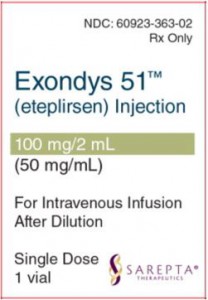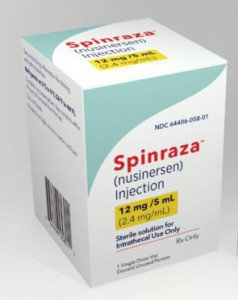The public debate on drug pricing has sharpened markedly over the past year. We are seeing more political scrutiny and media coverage, including the blowback on Mylan’s EpiPen pricing, tweets from now President Trump, as well as an unsuccessful California ballot initiative to force lower drug prices. This is all on top of a backdrop of seemingly ever-increasing coverage of the high costs of new medicines and double-digit price increases. Now market forces may be gearing up: in the past four months, Anthem — one of the “Big 3” payers covering 40 million lives or 1 in 8 Americans– has made two noteworthy coverage decisions on new higher priced drugs in the rare disease space. What do Anthem’s moves signal about the future likelihood of payers pushing back on drug prices?
In Octob er, Anthem announced that Exondys 51 (eteplirsen), Sarepta Therapeutics’ drug for Duchenne muscular dystrophy would not be covered, stating that the “use of eteplirsen is considered investigational and not medically necessary.” This investigational status was arguably contrary to FDA’s decision several weeks earlier, when it formally approved the drug. The FDA’s decision was controversial, inside and outside of FDA, given broadly acknowledged “significant flaws in the study design” and weak clinical findings.
er, Anthem announced that Exondys 51 (eteplirsen), Sarepta Therapeutics’ drug for Duchenne muscular dystrophy would not be covered, stating that the “use of eteplirsen is considered investigational and not medically necessary.” This investigational status was arguably contrary to FDA’s decision several weeks earlier, when it formally approved the drug. The FDA’s decision was controversial, inside and outside of FDA, given broadly acknowledged “significant flaws in the study design” and weak clinical findings.
On the day Exondys51 was approved, Sarepta announced that it would have an average net cost of $300,000 per year, factoring in variations in patient body weight, compliance and government discounts. Some analysts thought Sarepta was offering bargain pricing as a reaction to heightened scrutiny on drug pricing. Yet Anthem clearly interpreted the facts differently. They noted that FDA’s accelerated approval was based on an unpublished, open-label study that demonstrated an ability to increase dystrophin levels, but Anthem was unconvinced that this would translate into clinical benefit. FDA is requiring Sarepta to conduct a follow-up study to demonstrate clinical benefit for full approval, and Anthem decided that at $300,000, they were not going to cover the drug in the meantime. They key question following Anthem’s decision: was this an isolated case of denying coverage to a highly controversial drug with flawed data? Or are the others to come?
The first potential answer to that question comes in the form of last Friday’s decision from Anthem to limit coverage of Biogen’s new drug for Spinal Muscular Atrophy, Spinraza (nusinersen).  Biogen created some buzz over the holidays, first with the announcement of the quick approval, which is the first drug approved for patients with this debilitating neuromuscular disease. This was followed by the announced pricing, which is $750,000 in the first year, followed by $375,000 in subsequent years. While Biogen pointed out that many rare disease drug prices are misleadingly low given their weight-based dosing, many were surprised by the price of the drug.
Biogen created some buzz over the holidays, first with the announcement of the quick approval, which is the first drug approved for patients with this debilitating neuromuscular disease. This was followed by the announced pricing, which is $750,000 in the first year, followed by $375,000 in subsequent years. While Biogen pointed out that many rare disease drug prices are misleadingly low given their weight-based dosing, many were surprised by the price of the drug.
There are important differences with the Exondys 51 case. Unlike that situation, the data package for Spinraza was more robust. Statistically significant clinical impact was demonstrated in multiple double-blind, placebo controlled studies, coupled with additional data from several others. However, there are multiple types of SMA, with different timing of onset (infantile vs later in youth) and severity (death vs physical disability, including being wheel-chair bound). FDA approved a broad label for all types of SMA, while noting that several disease types have supportive data from open-label studies, with blinded and placebo-controlled trials still underway. Like with Exondys51, Anthem is reviewing the facts and drawing a different conclusion than FDA. In this case, they have deemed Spinraza to be “be medically necessary” for only SMA type 1, excluding types 2-4. Anthem notes that “there is no evaluable published data on the safety and efficacy of nusinersen in individuals” beyond type 1, highlighting that Spinraza’s package insert includes information for these patients from several open-label, unpublished studies. So while FDA approved the drug broadly, Anthem will be restricting use to a subset of patients.
What are the takeaways?
First, caution in over-interpreting these two data points. FDA approval of Exondys 51 was uniquely controversial and Anthem is the only insurer to restrict use of Spinraza so far. These are drugs with price points that are orders of magnitude higher than other drugs, so the impact of these decisions on primary care therapies, or higher-cost (but still ~5-10x cheaper than these examples) specialty drugs remains to be seen. But there are lessons to be learned from these cases.
1. There are consequences to the broader public debate on drug pricing, even if no policy changes are on the horizon.
Notably, both of these cases involve therapies to combat debilitating diseases in young children. Traditionally, the political dynamic was such that a payer would be foolish to risk the wrath of parents, disease advocacy groups, politicians and the public at-large for denying access to these medications for children. But with the pushback against drug pricing and the consequent impact on biopharma’s image, the political scales look to be changing.
2. The days of rare disease drug prices being ignored are over.
While traditionally rare disease drug prices have been higher than other drugs, their overall cost impact was small enough given their infrequent use, that most payers have ignored them. With prices reaching new levels, affording an ROI to biopharma that makes them increasingly attractive compared to drugs targeted for a broader population, this cost category is among the fastest growing for payers. The numbers may still be smaller than other drug and health care spending categories, but with the number of drugs in the pipeline, payers are paying closer attention.
3. The accelerated approval process needs to be coupled with creative approaches to commercializing these therapies.
FDA has been rightfully lauded with increasing access to innovative therapies, enabling an interim approval while further studies proving clinical benefit more deeply are still underway. However, these drugs are then entering the marketplace with relatively less complete evidence, but price tags that are significant. Biopharma and payers need to work together to identify an approach that offers the system overall value, while providing necessary incentives for future R&D in these high unmet need diseases. Biopharma is concerned about not setting the full price at the onset, knowing that a more compelling data package a few years in the future would hardly enable them to justify a substantial increase in price. However, payers are being forced to deny coverage to drugs with uncertain benefit (for some or all patients) with a significant cost to the system. Outcomes-based pricing, where some reimbursement is linked to resulting clinical outcomes, as we have explored in the past, is a promising solution here.
It is still unclear whether these cases are just an isolated two not to be followed, or the beginning of a new trend. Given the signals, however, it would be prudent for biopharma, as well as payers, to work together and prevent more spillover in the public arena, limiting the need for another reactive approach like we saw in the Mylan-EpiPen situation.
